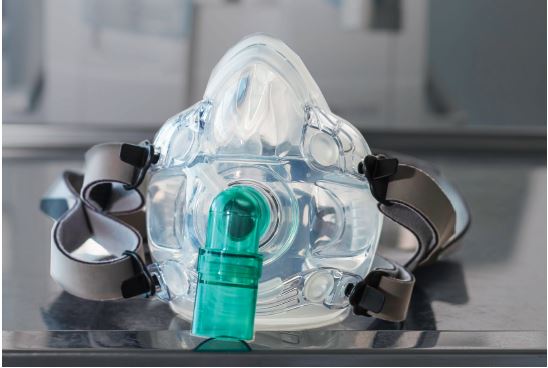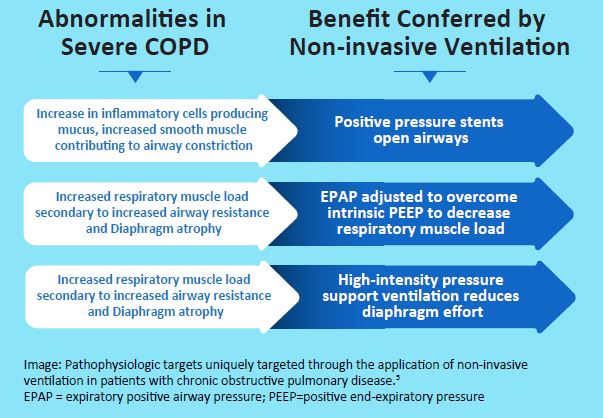Chronic obstructive pulmonary disease or COPD is a common, preventable, and treatable condition characterized by persistent respiratory symptoms and airflow limitation due to structural abnormalities in the airways and alveoli. The prevalence of COPD has been consistently rising over the past several years, with an estimated 44% increase in the global burden of COPD in the past decade.
The prevalence of COPD in India has increased from 3.3% (28.1 million cases) in 1990 to 4.4% (55.3 million cases) in 2016. It is also the second most common cause of non-communicable disease-related mortality in India.1,2


COPD is characterized by chronic inflammatory changes affecting the airways,
lung parenchyma, and pulmonary vasculature. The chronic inflammatory response
and subsequent tissue destruction lead to airflow limitation and impaired gas
exchange. As the disease progresses, impairment of gas exchange leads to CO2
retention and hypoxia. Occasionally, certain triggers (bacterial or viral
pneumonia, environmental irritants, etc.) can trigger an acute exacerbation
characterized by an acute worsening of respiratory symptoms which can progress
to acute respiratory failure.3
Significant advances in the care of COPD patients has helped reduce disease
mortality, however, it has also likely resulted in them living longer with
advanced COPD. This has created a need to explore therapies beyond the
traditional management options like inhaled bronchodilators,
corticosteroids, pulmonary rehabilitation, etc.3
Non-Invasive Ventilation (NIV) refers to the administration of external
ventilatory support without using an invasive artificial airway (endotracheal
tube or tracheostomy tube). It may help avert some of the complications
inherent with invasive ventilation, such as the need for sedation, risks of
hemodynamic instability, nosocomial infection, etc. NIV consists of the
delivery of positive pressure ventilation via an external interface such as
facemask, nasal mask, etc.4

NIV is a promising modality to decrease work of breathing
and improve respiratory mechanics in COPD patients through its beneficial
effects on several pathophysiologic abnormalities seen in severe COPD.5

Non-invasive ventilation has been effectively studied in acute exacerbations
of COPD and is known to confer benefits like reduced mortality, reduced need
for endotracheal intubation, and decreased hospital stay. Recently, there have
been studies done that demonstrated a beneficial effect of home-based NIV in
stable COPD patients, outside of acute exacerbations. The inclusion of NIV as a
therapy in acute or stable COPD is extensively studied in the ISCCM Guidelines
and ERS Guidelines and they have laid down expert recommendations in their
publications.
The use of NIV in patients with COPD exacerbation has been well established
for more than two decades.
The use of NIV during COPD exacerbations helps prevent the development of acute
respiratory acidosis and the need for invasive mechanical ventilation. It is
also used as a therapeutic alternative to invasive mechanical ventilation in
patients with severe acidosis and respiratory distress.

The Indian Society of Critical Medicine (ISCCM) recommends the use of
NIV in the following situations pertaining to COPD6
Key Highlights of ISCCM 2020 Guidelines6
● NIV should be used in the management of acute exacerbation of COPD in
patients with acute or acute-on-chronic respiratory acidosis (pH = 7.25-7.35)
● NIV should be attempted in patients with acute exacerbation of COPD (pH
<7.25 & PaCO2 ≥ 45) before initiating invasive mechanical ventilation,
except in patients requiring immediate intubation
● NIV should not be used routinely in normo- or mildly hypercapnic patients
with acute exacerbation of COPD, without acidosis (pH > 7.35)
Non-invasive ventilation is increasingly being used as a long-term treatment
in COPD patients with hypercapnic chronic respiratory failure, however, there
exists a paucity of clinical evidence supporting the benefits of long-term home
NIV in such cases. The European Respiratory Society (ERS) task force have
developed evidence-based guidelines on the application of long term home NIV
(LTH-NIV) for patients with hypercapnic COPD having chronic respiratory
failure.
COPD remains a leading cause of hospital admissions and mortality in
spite of multi-modality treatments with pharmacotherapy, pulmonary
rehabilitation, supplemental oxygen, lifestyle interventions, etc. The use of
NIV in the acute setting, as well as a long-term home-based modality, seems to
be a promising approach to reduce untoward disease outcomes.
References: